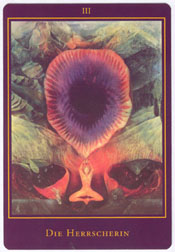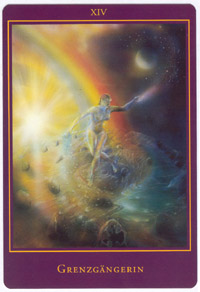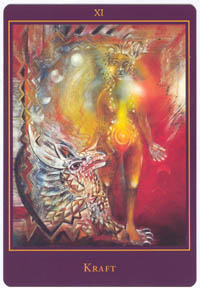|
 It is years since I first heard of Margarete Petersen's tarot. The first cards appeared in the early 1980's
as cover illustrations on tarot books with a feministic stamp, like Louisa Francia's, "Hexentarot" and the
German edition of Billie Potts', "A New Women's Tarot". For years, rumors were that Frau Petersen was still
working on her deck, and the rumors were confirmed, since I occasionally stumbled upon a postcard, depicting
one of her characteristic major arcana cards. On the back of the postcards, Margarete Petersen's address was
printed. What could be easier than writing to her to obtain the full set, and to ask some questions? Who would
believe, that Frau Petersen wasn't eager to get a response to her work, or at least wasn't eager to sell her
postcards, hence the address. However, no response! I mentioned that fact in MANTEIA, and our German expert
dealer, MGM in Munich, let us know, that they stocked the seventeen postcards, so far published. Finally I
could hold in my hands, not a complete major arcana of the Margarete Petersen Tarot, but close to it.
It is years since I first heard of Margarete Petersen's tarot. The first cards appeared in the early 1980's
as cover illustrations on tarot books with a feministic stamp, like Louisa Francia's, "Hexentarot" and the
German edition of Billie Potts', "A New Women's Tarot". For years, rumors were that Frau Petersen was still
working on her deck, and the rumors were confirmed, since I occasionally stumbled upon a postcard, depicting
one of her characteristic major arcana cards. On the back of the postcards, Margarete Petersen's address was
printed. What could be easier than writing to her to obtain the full set, and to ask some questions? Who would
believe, that Frau Petersen wasn't eager to get a response to her work, or at least wasn't eager to sell her
postcards, hence the address. However, no response! I mentioned that fact in MANTEIA, and our German expert
dealer, MGM in Munich, let us know, that they stocked the seventeen postcards, so far published. Finally I
could hold in my hands, not a complete major arcana of the Margarete Petersen Tarot, but close to it.
 I still hoped, that Margarete Petersen would be cooperative in putting this portrait together, but one more
letter remained unanswered. The German New Age magazine, Esotera, had better luck, since they shared an
illustrated article, written by Irene Dalichow, in their issue no. 5/1990. My article is therefore based on
information given by Mrs. Dalichow.
I still hoped, that Margarete Petersen would be cooperative in putting this portrait together, but one more
letter remained unanswered. The German New Age magazine, Esotera, had better luck, since they shared an
illustrated article, written by Irene Dalichow, in their issue no. 5/1990. My article is therefore based on
information given by Mrs. Dalichow.
Margarete Petersen's interest in tarot began, while during the 1980 New Year, she was snowbound, with her two
sisters, in a house in the countryside. One sister had brought the Waite/Smith-deck, which was used, when
they had to decide, whom of them had to go out in the snow to get supplies. Margarete Petersen drew the Five
of Coins from the pack! After that, her earlier life as a politically engaged squatter, film producer,
housewife and mother, was left behind, and she moved with her daughter and her three sisters, and their
three children, to a small village in the South of Germany. Tarot became her entire life, and her only
income came from the sale of the postcard series.
 The creative process is long and persistent. Hundreds of different versions of each card are made, before the
deeper content is expressed in a form, that the artist herself feels is satisfactory.
Then finally, after
months and sometimes years, the card is ready to be released for reproduction. Margarete Petersen is
(according to Irene Dalichow) convinced that the tarot originates from ancient Egypt or even earlier, and
that the creative process it underwent at that time, was similar to what she is now experiencing. She sees
the process as a healing process for herself, a lengthy period, in which she
entirely emerges into the
symbolism and atmosphere of the particular card, she is working on. Thus her dreams and trances can be
expressed in her art. This identification has to be complete; when she, for instance, started working on The
Sun, she redecorated her studio and living room, painting it all in gold and red, to have the constant
feeling of the sun's light around her. There is work waiting for Margarete Petersen for the rest of her
lifetime. As I understand it, her concept of a tarot deck deals with 78 cards.
The creative process is long and persistent. Hundreds of different versions of each card are made, before the
deeper content is expressed in a form, that the artist herself feels is satisfactory.
Then finally, after
months and sometimes years, the card is ready to be released for reproduction. Margarete Petersen is
(according to Irene Dalichow) convinced that the tarot originates from ancient Egypt or even earlier, and
that the creative process it underwent at that time, was similar to what she is now experiencing. She sees
the process as a healing process for herself, a lengthy period, in which she
entirely emerges into the
symbolism and atmosphere of the particular card, she is working on. Thus her dreams and trances can be
expressed in her art. This identification has to be complete; when she, for instance, started working on The
Sun, she redecorated her studio and living room, painting it all in gold and red, to have the constant
feeling of the sun's light around her. There is work waiting for Margarete Petersen for the rest of her
lifetime. As I understand it, her concept of a tarot deck deals with 78 cards.
I have rendered a few cards here: The Empress, Strength and Temperance. The cards have
often been characterized as a women's tarot, but even if there are feminine undertones in Margarete
Petersen's imagery, they are quite different from most other decks referred to
in that category. In any case,
there is no apparent fundamentalist feminism. The cards are a series of images of dreams, that show us
fragments of our unconscious. Margarete Petersen's tarot is, what I would call a
meditational deck, not a
deck for readings.
|